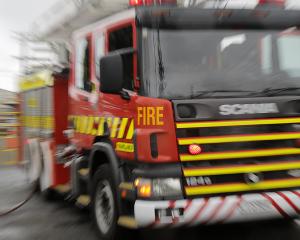
On the night of June 17, passengers on an outbound Virgin flight from Queenstown to Melbourne reported flames shooting from the back of their Boeing’s starboard engine, after a suspected bird strike during take-off. They were diverted to land in Invercargill.
Invercargill Airport chief executive Stuart Harris and operations manager Rob Somers both said they were incredibly proud of the airport and city’s emergency services, which seamlessly dealt with the emergency.
"The different agencies were like one family who absolutely clicked and hummed along."
There were only minor takeaways from the incident debrief.
The emergency happened after most staff had gone home.
"It was an acid test, but it was an acid test when there was the fewest staff ever at the airport."
Off-duty staff dropped what they were doing to immediately respond and Air New Zealand’s on-duty staff stepped in to provide help with the stressed passengers.
The captain chose to land at Invercargill Airport on one engine, where well-drilled emergency response teams were on hand.
"No-one knew what was going to happen ... It all looked smooth from the outside."
Machines sat ready and "there was a collective silence as it actually came in".
"You’ve got to get 7000 litres of water and thousands of litres of foam to the end of the runway in 180 seconds ...
"Which means you’ve got to have a fire truck that not only weighs 30 tonnes but can actually accelerate like the average family car," Mr Somers said.
Responses were managed in stages.
"It depends on what unfolds when this thing lands. It could have been adverse, really bad ... But initially, when that plane touches down, it’s the fire service that was in charge of it, Mr Harris said.
"The moment the plane came to a stop, the captain would relinquish control over to the [Fire and Emergency New Zealand] officer."
Aircraft performing emergency landings had significant and abnormal stress on their mechanical systems.
The Boeing sat on the Invercargill tarmac until emergency staff were satisfied there were no further associated risks.
"[The pilot] had to wait until [Fenz] was satisfied the brakes had cooled down ... and there’s no risk of wheels exploding because of heat, [or threat] to human life and that sort of thing."
While the pilot had not landed at Invercargill Airport before, it had a good runway.
"That’s the nice thing about this airport — it’s a really long runway, it’s flat and there’s no big mountains around it, so it makes it a bit more palatable ... if you are having a bad day in the office and want to land in a flat terrain.
"It’s a runway that can cope with a lot."
He understood the plane’s flight path briefly circled over the Oreti Beach region, not to dump fuel, but to allow the pilot and crew enough time to complete an important emergency landing checklist before what the pilot described as a "hot" landing, Mr Harris said.
"Everything we saw suggested they were calm and composed," Mr Somers said.
"Everybody, without exception, is in awe of what they did in that cockpit. I’m sure Virgin will recognise that — they really did it well," Mr Harris said.
The runway was routinely inspected for debris before every flight, but due to the increased potential of debris coming from the damaged aircraft, Mr Harris ordered a double check to be done of the runway ahead of the last inbound evening flights.
The 74 passengers and crew were kept in the airport’s secure lounge to provide them a safe place to unwind after their ordeal.
Mr Somers confirmed the damaged aircraft was now being repaired by a team of Virgin staff on site in a hanger designed for early Boeing 737s.
The plane returned to Australia on Wednesday.
While the airport had been placed on emergency stand-by or used as a unscheduled stop-over, it had been almost a decade since a damaged plane had to be repaired on site.
A private jet cautioned ground crew of a potential problem, triggering the week’s second emergency callout on June 19.
"I would describe that as precautionary, a safety-first thing. However, it still had the whole team turn out with Fenz, police and everybody," Mr Harris said.
By Toni McDonald











